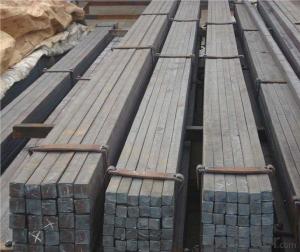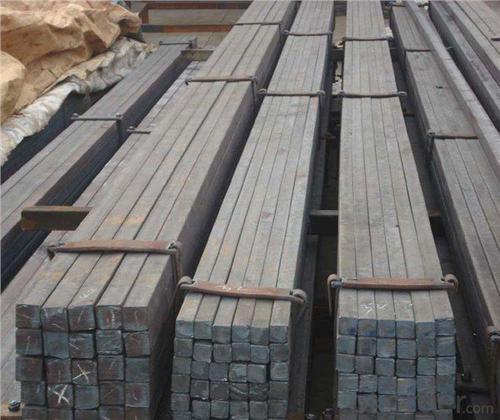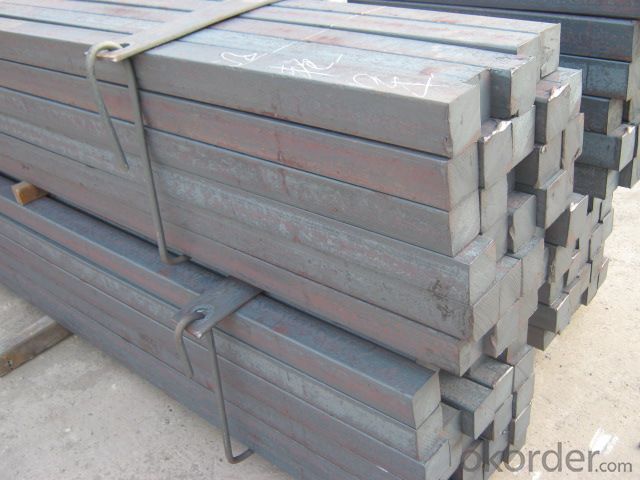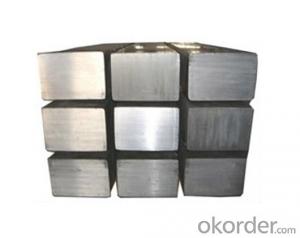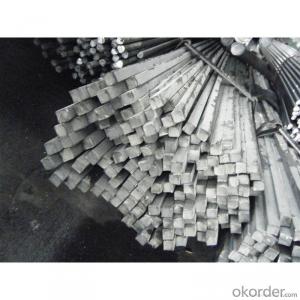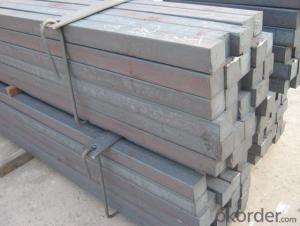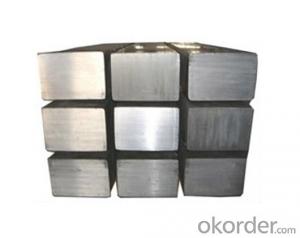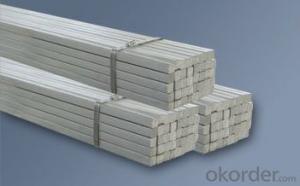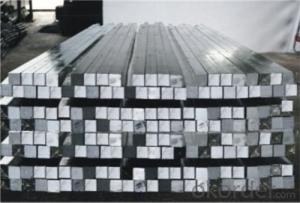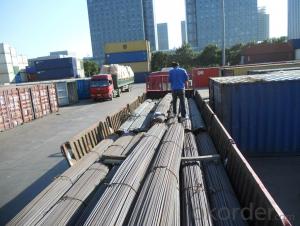Steel Square Bar High Quality 5mm-100mm Q195 or Q235
- Loading Port:
- Shanghai
- Payment Terms:
- TT or LC
- Min Order Qty:
- 50 m.t.
- Supply Capability:
- 20000 m.t./month
OKorder Service Pledge
OKorder Financial Service
You Might Also Like
Product Description:
OKorder is offering High Quality Square Bar 5mm-100mm Q195 or Q235 at great prices with worldwide shipping. Our supplier is a world-class manufacturer of steel, with our products utilized the world over. OKorder annually supplies products to European, North American and Asian markets. We provide quotations within 24 hours of receiving an inquiry and guarantee competitive prices.
Product Applications:
1) Suitable for making various strong cutting tool abrasion resistance, impact resistance.
2) Used to produce all kinds of high hard and super hard saw blade, drill, tap, broach, gear hob and various kinds of milling cutter.
3) Used for advanced punching die, screw die, and the toughness and complicated shape of the punch, etc.
4) Is used for cold forging die and drawing mode, etc.
5) Recommended watchcase factory, screw factory and other cold stamping products industry use.
Product Advantages:
OKorder's High Quality Square Bar 5mm-100mm Q195 or Q235 are durable, strong, and resist corrosion.
Main Product Features:
· Premium quality
· Prompt delivery & seaworthy packing (30 days after receiving deposit)
· Corrosion resistance
· Can be recycled and reused
· Mill test certification
· Professional Service
· Competitive pricing
Product Specifications:
Standard: GB,
-Grade: Q195 or equivalent.
-Chemical Composition:
Standard | Grade | Element (%) | ||||
GB | Q195 | C | Mn | S | P | Si |
0.06~0.12 | 0.25~0.50 | ≤0.050 | ≤0.045 | ≤0.30 | ||
Measures of HR Square Bar (small measures):
-Length of a side and Theoretical weight of Square Bar.
Length of a side(mm) | Theoretical weight(kg/m) | Length of a side(mm) | Theoretical weight(kg/m) |
7 | 0.385 | 22 | 3.80 |
8 | 0.502 | 24 | 4.52 |
9 | 0.636 | 25 | 4.91 |
10 | 0.785 | 26 | 5.30 |
11 | 0.950 | 28 | 6.15 |
12 | 1.13 | 30 | 7.06 |
13 | 1.33 | 32 | 8.04 |
14 | 1.54 | 34 | 9.07 |
15 | 1.77 | 36 | 10.17 |
16 | 2.01 | 38 | 11.24 |
17 | 2.27 | 40 | 12.56 |
18 | 2.54 | 42 | 13.85 |
19 | 2.82 | 45 | 15.90 |
20 | 3.14 | 48 | 18.09 |
21 | 3.46 | 50 | 19.63 |
Notes:
1, The theoretical weights in the list, base on the density of 7.85 g/cm3.
2, Formula for theoretical weight of Square bar: (length of a side)2 * 0.00785
3, The numbers with *mean that they are not regular or we don’t offer them.
-Regular length of Square Bar:
Steel | Length of a side (mm) | Length of steel (m) |
Normal steel | < 25 | 4~10 |
> 25 | 3~9 | |
Steel of high quality | All measure | 2~6 |
Tool steel >75 | 1~6 |
FAQ:
Q1: Why buy Materials & Equipment from OKorder.com?
A1: All products offered byOKorder.com are carefully selected from China's most reliable manufacturing enterprises. Through its ISO certifications, OKorder.com adheres to the highest standards and a commitment to supply chain safety and customer satisfaction.
Q2: How do you package the angle steel when shipping?
A2: All goods are packed in bundles with steel strips and shipped by container or break bulk.
Q3: The products are invoicing on theoritical weight or on actual weight?
A3: We can do it in both manners, according to the customers' request.

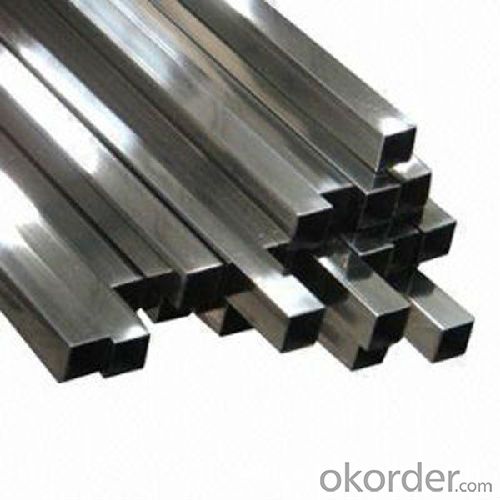
- Q: Can a steel square be used for checking the squareness of a bookshelf?
- No, a steel square cannot be used for checking the squareness of a bookshelf. A steel square, also known as a carpenter's square or a try square, is primarily used for measuring and marking right angles in woodworking and carpentry. It is not designed to accurately determine the squareness of a complex structure like a bookshelf. To check the squareness of a bookshelf, a more appropriate tool would be a combination square or a framing square, as these are specifically designed to measure and verify right angles in larger structures. Additionally, a level or a measuring tape can also be used to ensure the bookshelf is level and accurately aligned. Using the correct tools for the task at hand is crucial to achieving accurate and precise results.
- Q: What are some common uses for a steel square in deck construction?
- Deck construction relies heavily on the use of a steel square, also known as a framing square, due to its versatility and importance. This tool is primarily utilized for precise angle measurements, markings, and cuts. Several common applications of a steel square in deck construction include: 1. Ensuring square corners: The steel square's 90-degree angle is ideal for guaranteeing that corners are square and properly aligned. Builders can utilize it to assess and adjust the deck's frame corners, ensuring accurate and precise construction. 2. Establishing the deck's layout: A steel square is useful in laying out the deck's perimeter and marking the precise positions for the placement of posts, beams, and joists. It aids in creating straight and parallel lines, resulting in a symmetrical and well-balanced deck structure. 3. Marking and cutting angles: Deck construction often involves cutting angles, especially for stair stringers, joist hangers, and other components. The steel square's accuracy in measuring and marking various angles enables builders to ensure precise cuts that fit together seamlessly. 4. Checking for level and plumb: Builders can employ a steel square to verify if posts and beams are plumb (vertical) and if joists and deck boards are level (horizontal). By aligning the square against the components and utilizing a level, builders can ensure the deck's structure is straight and properly aligned. 5. Measuring and marking dimensions: The long blade and tongue of a steel square allow for accurate measurements and markings. Whether it involves determining the length and width of deck boards, marking out notches, or measuring distances between joists, the steel square provides precise measurements for all deck components. Overall, the steel square is an indispensable tool in deck construction. Its versatility and accuracy in measuring, marking, and checking angles make it an essential asset for guaranteeing a well-built and structurally sound deck.
- Q: How do you use a steel square to determine the angle of a cove cut?
- To determine the angle of a cove cut using a steel square, you can follow these steps: 1. Place the steel square on the workpiece so that one arm rests against the edge of the material. 2. Align the other arm of the square with the direction in which you want to make the cove cut. 3. Read the angle measurement on the scale of the steel square where the second arm intersects it. 4. This angle measurement will indicate the angle at which you need to position your saw or cutting tool to create the desired cove cut.
- Q: How do you use a steel square to find the square footage of a roof?
- To use a steel square to find the square footage of a roof, you will need to follow a few steps. First, you need to determine the pitch or slope of the roof. The pitch is usually given as a ratio, such as 4:12 or 6:12, which means for every 12 inches of horizontal run, the roof rises 4 or 6 inches vertically. Next, you will need to measure the length and width of the roof. Use the steel square as a measuring tool by placing one edge on the roof's surface and the other edge against the vertical surface, such as a wall or fascia board. This will allow you to measure the length and width accurately. Once you have these measurements, you can multiply the length and width to calculate the square footage of the roof. However, keep in mind that with a sloped roof, you need to take the pitch into account. To do this, multiply the length by the width, and then multiply the result by the pitch factor. The pitch factor is found by dividing the vertical rise by the horizontal run. For example, if the pitch is 4:12, the pitch factor is 4/12, which simplifies to 1/3. Finally, divide the total square footage by 100 to convert it to roofing squares. Roofing squares are a common unit of measurement in the roofing industry, where one square equals 100 square feet. In summary, using a steel square to find the square footage of a roof involves measuring the length and width of the roof, considering the pitch or slope, multiplying the measurements, and then converting the result to roofing squares if necessary.
- Q: Can a steel square be used for checking the flatness of surfaces?
- The flatness of surfaces can be checked using a steel square. This versatile tool is commonly utilized in woodworking and metalworking. It is comprised of a flat, straight edge and a perpendicular, right-angle edge that enables precise measurements and alignments. To assess surface flatness, simply place the steel square on the surface and observe its positioning. If the surface is completely flat, the square will maintain consistent contact along its entire length. Conversely, if the surface is uneven, you will notice gaps or inconsistent contact between the square and the surface. While using a steel square for flatness checks is a quick and straightforward method, it's important to acknowledge that it may not provide the same level of accuracy as specialized tools like a surface plate or straight edge ruler. For critical applications or highly precise measurements, it is advisable to employ more accurate instruments.
- Q: How do you use a steel square to measure the width of a worktable?
- To use a steel square to measure the width of a worktable, place one arm of the square against the edge of the table and align the other arm perpendicular to it. Take note of the measurement where the second arm intersects the opposite edge of the table. This measurement represents the width of the worktable.
- Q: What are some common measurements that can be taken with a steel square in plumbing rough-ins?
- Some common measurements that can be taken with a steel square in plumbing rough-ins include determining angles for cutting pipes, checking for squareness and alignment of pipes and fixtures, measuring distances and dimensions accurately, and ensuring proper fit and alignment of pipes and fittings.
- Q: Can a steel square be used for measuring the height of a building?
- No, a steel square cannot be used for measuring the height of a building as it is a tool primarily used for right angle measurements in carpentry and not suitable for measuring vertical distances.
- Q: How do you use a steel square to measure diagonal distances?
- To use a steel square to measure diagonal distances, you will need to follow a few simple steps. First, position the steel square on the object or surface you wish to measure. Make sure that one edge of the square aligns with the starting point of the diagonal distance you want to measure. Next, extend the other edge of the square until it reaches the endpoint of the diagonal distance. Ensure that the square is firmly held against the object or surface, maintaining a straight and accurate line. Once the square is in position, take note of the point where the extended edge intersects with the diagonal distance. This intersection point will help you determine the measurement. Finally, measure the distance from the starting point to the intersection point using the markings on the steel square. The steel square typically has clear and precise measurements etched onto its surface, allowing you to easily determine the diagonal distance. Remember to always handle the steel square with care and ensure it is properly aligned for accurate measurements.
- Q: How do you use a steel square to measure diagonals?
- To use a steel square to measure diagonals, simply place the square against the corner of the object or surface you want to measure. Align one edge of the square with one side of the object and make sure the other edge is perpendicular to it. Then, measure the diagonal by extending the other edge of the square until it reaches the opposite corner. The measurement you obtain is the length of the diagonal.
Send your message to us
Steel Square Bar High Quality 5mm-100mm Q195 or Q235
- Loading Port:
- Shanghai
- Payment Terms:
- TT or LC
- Min Order Qty:
- 50 m.t.
- Supply Capability:
- 20000 m.t./month
OKorder Service Pledge
OKorder Financial Service
Similar products
Hot products
Hot Searches
Related keywords


